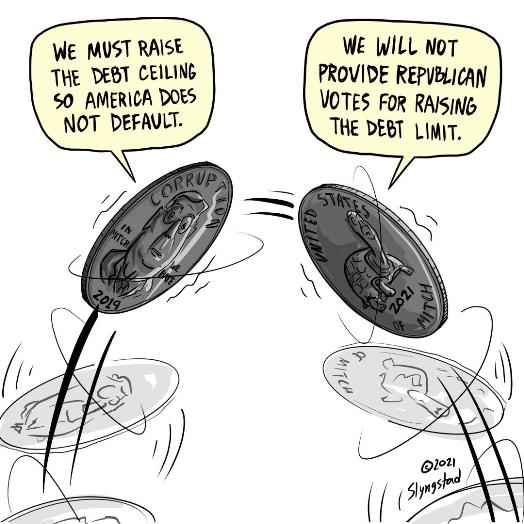![]()
![]()
from Bruce
Anecdotes
Money
• Sylvia Miles became an actress because she was incompetent at procuring theatrical props. She was working as a set designer at a Long Island theater when the producer sent her out to get some props. She returned after purchasing the props for $90. This shocked the producer, who told her, “You’re not supposed to pay for props. You’re supposed to rent or borrow them and give them billing.” Ms. Miles, of course, wanted her $90 back, so the producer said, “Tell you what. I’m going to give you a part in the play, and I’ll give you $90 to play the part.”
• The Marx Brothers flopped in London with a vaudeville skit called “On the Mezzanine.” During the skit, the Londoners began to throw pennies on the stage — a deadly insult. Groucho went to the front of the stage, raised his hand for silence, then said, “If you people are going to throw coins, I wish to h*ll you’d throw something more substantial — like shillings or guineas.” This joke was quoted throughout London, and the Marx Brothers became successful in London with a different skit titled “Home Again.”
• People who provide financial backing for Broadway shows are called “angels,” perhaps because they seldom get back their money. Marc Connelly wrote a play based on Roark Bradford’s Ole Man Adam and His Chillun, and convinced a banker named Rowland Stebbins to put up the money to produce it. Afterwards, Mr. Connelly introduced Mr. Stebbins to a couple of friends, saying, “Meet the sucker!” (Mr. Stebbins wasn’t a sucker. Mr. Connelly’s play, The Green Pastures, was a huge hit and won the Pulitzer Prize.)
• Early in his career, jazz great Duke Ellington was asked to write some songs for a musical. He didn’t know that composers often took months to write for a musical, so he stayed up all night writing four songs, and in the morning he took them to the musical’s promoter, Jack Robbins, who paid $500 for the songs after pawning his wife’s engagement ring. Mr. Robbins then took the musical to Germany, where it played for two years and made him a millionaire.
• Famed theater director Tyrone Guthrie liked to tell this story on himself. He had given an ex tempore speech in Vancouver about theater, but because he had just gotten off a plane and was tired, he had not spoken very well. After the speech, a famous Vancouver eccentric, Mrs. Clegg, approached him and said, “I’ve been sitting here listening to you for the last 45 minutes, and you haven’t said anything. I paid $1.50, and I want my $1.50 back.” Mr. Guthrie gave her $1.50.
• Sir Barry Jackson once directed an amateur production of Shakespeare’s Twelfth Night with John Drinkwater as Malvolio. During one outdoor performance, a rainstorm blew up and the audience left en masse, except for a couple of old ladies who remained huddled under an umbrella. Sir Barry hissed to Mr. Drinkwater, “You must go on, or we shall have to repay their money.”
• Lee Schubert understood finances. Once, he sold the movie rights to a 10-year-old play and without consulting a contract to refresh his memory knew who had a share in the money thus obtained. One of the sharers was actor Leo Ditrichstein, from whose check Mr. Schubert deducted a few dollars that Mr. Ditrichstein had owed him for several years.
• As a young man, humorous poet Don Marquis worked as a journalist for $18 a week and once turned down a job to work as an actor for $15 a week. He explained later that he had decided to stay in writing because of “the big money.” (Actually, he was right — later he wrote a play titled The Old Soak that made him $85,000.)
***
© Copyright Bruce D. Bruce; All Rights Reserved
***
The Funniest People in Theater: 250 Anecdotes — Buy
The Funniest People in Theater: 250 Anecdotes — Buy The Paperback
The Funniest People in Theater: 250 Anecdotes — Buy Kindle
The Funniest People in Theater: 250 Anecdotes — Buy Apple
The Funniest People in Theater: 250 Anecdotes — Buy Barnes and Noble
The Funniest People in Theater: 250 Anecdotes — Buy Kobo
The Funniest People in Theater: 250 Anecdotes — Buy Smashwords: Many Formats, Including PDF
Presenting
Michael Egan







 In memory.
In memory.


BRUCE'S RECOMMENDATION
BANDCAMP MUSIC
BRUCE'S RECOMMENDATION OF BANDCAMP MUSIC
Music: "Cross You Bear"
Album: SOURWOOD
Artist: Adam Remnant
Artist Location: Ohio
Info: “Adam Remnant is a singer-songwriter of the folk & rock variety from Ohio.”
Price: $1 (USD) for track; $10 (USD) for nine-track album
Genre: Singer-Songwriter. Folk.
Links:
SOURWOOD
Adam Remnant on Bandcamp
Adam Remnant on YouTube
Adam Remnant Official Website
Other Links:
Bruce’s Music Recommendations: FREE pdfs
David Bruce's Amazon Author Page
David Bruce's Smashwords Page
David Bruce's Blog #1
David Bruce's Blog #2
David Bruce's Blog #3
David Bruce's Apple iBookstore
David Bruce has over 140 Kindle books on Amazon.com.

Reader Suggestion
Michelle in AZ

Stephen Suggests
Debt Ceiling



Bonus Links
Jeannie the Teed-Off Temp

Reader Comment
Current Events




Linda >^..^<
We are all only temporarily able bodied.
Thanks, Linda!


that Mad Cat, JD

In The Chaos Household
Last Night
Running late.

Son Loses Disney Trademark Case
![]()
Evel Knievel
A judge dismissed a trademark infringement lawsuit filed by Evel Knievel’s son a year ago against the Walt Disney Co. and movie company Pixar over a “Toy Story 4” daredevil character named Duke Caboom.
U.S. District Judge James Mahan in Las Vegas dismissed the case against Walt Disney Studios Motion Pictures on Sept. 23.
The judge wrote that while the Caboom character was “reminiscent” of Knievel, “Disney’s use of Evel Knievel’s likeness contains significant transformative elements” and is not a literal depiction.
Kelly Knievel, head of Las Vegas-based K and K Promotions, had characterized the Caboom character as “a direct knock-off of the legend and historical significance” of Knievel’s father, the famous stunt motorcyclist who died in 2007 at 69 in Florida of lung disease.
The lawsuit filed in September 2020 accused Disney and Pixar of intentionally modeling the “Toy Story 4” character on Knievel, whose stunts included motorcycle jumps in 1967 over the Caesars Palace fountain in Las Vegas — including a spectacular near-fatal crash — and in 1975 over a row of buses at Wembley Stadium in London.
Evel Knievel

Prime Time
Ratings
NBC opened the new television season with a dominant week against its rivals, and it wasn’t just football that was responsible.
The network’s Sunday night football franchise was by far last week’s most-watched prime time program, as it traditionally is each fall. But NBC said it was the first time it won television’s fall premiere week in 20 years when only entertainment programming — and not sports — is taken into account.
Total prime-time viewership on ABC, CBS, NBC and Fox was up 16% over the same week last year, which would ordinarily be cause for celebration. Yet because COVID-19 shut down television production for much of last year, there was little fresh programming for the traditional broadcast premiere week, and this year things were back to normal.
ABC’s “World News Tonight” led the evening news ratings race with an average of 8 million viewers. NBC’s “Nightly News” had 6.7 million and the “CBS Evening News” had 4.8 million.
For the week of Sept. 20-26, the top 20 prime-time shows, their networks and viewerships:
1. NFL Football: Green Bay at San Francisco, NBC, 19.69 million.
2. “NFL Pregame” (Sunday), NBC, 13.85 million.
3. NFL Football: Detroit at Green Bay, ESPN, 11.9 million.
4. “The OT,” Fox, 10.02 million.
5. “Football Night in America, Part 3,” NBC, 9.48 million.
6. “NCIS,” CBS, 8.45 million.
7. NFL Football: Carolina at Houston, NFL Network, 7.39 million.
8. “The Voice” (Tuesday), NBC, 7.35 million.
9. “Chicago Fire,” NBC, 7.28 million.
10. “The Voice” (Monday), NBC, 7.22 million.
11. “60 Minutes,” CBS, 7.2 million.
12. “FBI,” CBS, 7.124 million.
13. “FBI: Most Wanted,” CBS, 7.119 million.
14. “Chicago Med,” NBC, 6.81 million.
15. “NCIS: Hawai’i,” CBS, 6.58 million.
16. “Chicago PD,” NBC, 6.54 million.
17. “FBI: International,” CBS, 6.43 million.
18. “Survivor,” CBS, 6.25 million.
19. “The Sustainer,” NFL Network, 5.98 million.
20. “Law & Order: SVU,” NBC, 5.58 million.
Ratings
Reopening Halted
![]()
‘Aladdin’
The hit Broadway show “Aladdin” was canceled Wednesday night when breakthrough COVID-19 cases were reported within the musical’s company, a day after the show reopened, a worrying sign for Broadway.
“Through our rigorous testing protocols, breakthrough COVID-19 cases have been detected within the company of ‘Aladdin’ at the New Amsterdam Theatre,” the show announced on social media. “Because the wellness and safety of our guests, cast and crew are our top priority, tonight’s performance, Wednesday, Sept. 2 , is canceled.”
It was the first Broadway COVID-19 cancellation since shows resumed with Bruce Springsteen’s concert returning in July and “Pass Over” as the first play to debut in August.
The pandemic forced Broadway theaters to abruptly close on March 12, 2020, knocking out all shows and scrambling the spring season. Several have restarted, including the so-called big three of “Wicked,” “Hamilton” and “The Lion King.”
‘Aladdin’

Lost Album
David Bowie
Before David Bowie hit it big with “Space Oddity” in 1969, he spent years on the fringes of the UK recording industry, churning out songs like “I Dig Everything,” “Silly Boy Blue,” and “Liza Jane” that failed to make any impact with the general public. They were completely excised from his live repertoire after Ziggy Stardust turned him into a superstar, and only his most devoted fans familiarized themselves.
But in 2000, he re-recorded several tracks for an album he called Toy, which was ultimately shelved when he left Virgin in 2001. Now, the long-lost album is finally set for release — alongside two discs of outtakes from the sessions — on the box set David Bowie 5. Brilliant Adventure (1992 – 2001) will also include remastered editions of Black Tie White Noise, The Buddha of Suburbia, Outside, Earthling, and ‘hours…’ along with the live album BBC Radio Theatre, London, June 27th, 2000 and the odds and sods collection Re: Call 5. It arrives on November 26th as a seven-CD set, an 18-piece vinyl package, or a digital download.
The roots of Toy go back to the rehearsals for Bowie’s VH1 Storytellers concert in the summer of 1999 when he resurrected his 1965 single “Can’t Help Thinking About Me” for a story about his early days on the British pop music scene with Steve Marriott of the Small Faces.
He hadn’t touched the song in over 30 years and openly cringed at some of his lyric choices (“the worst lines I’ve ever written”), but he loved the new arrangement and it stayed in the setlist when they headed to Europe in the fall. “Joe Elliott from Def Leppard was at a show in Dublin [on November 10th, 1999] and he’s a huge fan,” says Bowie bandleader Mark Plati. “He came backstage and he was gushing about that song. He said, ‘You should do more of those.'”
On Wednesday, the singer’s estate released an official version of Toy track “You’ve Got a Habit of Leaving.”
David Bowie
Extinct
23 Species
Death’s come knocking a last time for the splendid ivory-billed woodpecker and 22 more birds, fish and other species: The U.S. government is declaring them extinct.
It’s a rare move for wildlife officials to give up hope on a plant or animal, but government scientists say they've exhausted efforts to find these 23. And they warn climate change, on top of other pressures, could make such disappearances more common as a warming planet adds to the dangers facing imperiled plants and wildlife.
Others such as the flat pigtoe, a freshwater mussel in the southeastern U.S., were identified in the wild only a few times and never seen again, meaning by the time they got a name they were fading from existence.
The factors behind the disappearances vary — too much development, water pollution, logging, competition from invasive species, birds killed for feathers and animals captured by private collectors. In each case, humans were the ultimate cause.
Another thing they share: All 23 were thought to have at least a slim chance of survival when added to the endangered species list beginning in the 1960s. Only 11 species previously have been removed due to extinction in the almost half-century since the Endangered Species Act was signed into law. Wednesday's announcement kicks off a three-month comment period before the species status changes become final.
23 Species

Totally Fake
The Vinland Map
An exhaustive analysis of the controversial Vinland Map has shown it to be a 20th-century forgery.
“The Vinland Map is a fake,” Raymond Clemens, curator at Yale University’s Beinecke Rare Book Library, told Yale News. “There is no reasonable doubt here. This new analysis should put the matter to rest.”
Clemens, along with Yale University conservators Marie-France Lemay and Paula Zyats, and also scientists from Yale’s Institute for the Preservation of Cultural Heritage, performed an extensive analysis of the Vinland Map, which came to light in 1957 when the British Museum, after suspecting a forgery, refused to buy it from a dealer. Yale eventually acquired the parchment map, announcing its existence to the public in 1965. A scholarly book was written about it, and it even managed to grace the front page of the New York Times.
The map, supposedly dating back to the 15th century, was a big deal because it added weight to the claim that Vikings landed in North America before Christopher Columbus. An apparent section of the North American coastline, labeled “Vinlanda Insula,” can be seen just southwest of Greenland. To be fair, this evidence—that Vikings landed in the Americas so long ago—was a big deal at the time but not a huge deal. In the 1960s, archaeological discoveries of Viking settlements at L’Anse aux Meadows in Newfoundland had already suggested as much.
That the Vinland Map might be a forgery was suspected from the get-go. Scholars immediately pointed out inconsistencies with other medieval texts, while work done in the 1970s hinted at the presence of modern inks. The purpose of this most recent investigation was to perform the most thorough analysis yet and to examine the parchment from top to bottom with newly available high-tech tools, such as X-ray fluorescence spectroscopy (XRF), field emission scanning electron microscopy (FE-SEM), and Raman microscopy. A big bonus was that the team could hold onto the map for as long as the investigation required.
The Vinland Map

Vanguard Cave
Gibraltar
A cave chamber sealed off by sand for some 40,000 years has been discovered in Vanguard Cave in Gibraltar — a finding that could reveal more about the Neanderthals who lived in the area around that time.
"Given that the sand sealing the chamber was [40,000] years old, and that the chamber was therefore older, it must have been Neanderthals," who lived in Eurasia from about 200,000 to 40,000 years ago and were likely using the cave, Clive Finlayson, director of the Gibraltar National Museum, told Live Science in an email.
While Finlayson's team was studying the cave last month, they discovered the hollow area. After climbing through it, they found it is 43 feet (13 meters) in length, with stalactites hanging like eerie icicles from the chamber ceiling. Along the surface of the cave chamber, the researchers found the remains of lynx, hyenas and griffon vultures, as well as a large whelk, a type of sea snail that was likely carried into the chamber by a Neanderthal, the archaeologists said in a statement.
The researchers are eager to see what they will find once they start excavating. One possibility is that the team will discover Neanderthal burials, Finlayson said. "We found the milk tooth of a 4-year-old Neanderthal close to the chamber four years ago," he said. The tooth "was associated with hyenas, and we suspect the hyenas brought the child [who was likely dead] into the cave."
Gibraltar

Balanced On Ice Pedestals
“Zen” Stones
Visit the Small Sea of Lake Baikal in Russia during the winter and you'll likely see an unusual phenomenon: a flat rock balanced on a thin pedestal of ice, akin to stacking Zen stones common to Japanese gardens. The phenomenon is sometimes called a Baikal Zen formation. The typical explanation for how these formations occur is that the rock catches light (and heat) from the Sun and this melts the ice underneath until just a thin pedestal remains to support it. The water under the rock refreezes at night, and it has been suggested that wind may also be a factor.
Now, two French physicists believe they have solved the mystery of how these structures form, according to a new paper published in the Proceedings of the National Academy of Sciences—and their solution has nothing to do with the thermal conduction of the stone. Rather, they attribute the formation to a phenomenon known as sublimation, whereby snow or ice evaporates directly into vapor without passing through a water phase. Specifically, the shade provided by the stone hinders the sublimation rates of the surrounding ice in its vicinity, while the ice farther away sublimates at a faster rate.
Many similar formations occur naturally in nature, such as hoodoos (tall, spindly structures that form over millions of years within sedimentary rock), mushroom rocks or rock pedestals (the base has been eroded by strong dusty winds), and glacier tables (a large stone sitting precariously on top of a narrow pedestal of ice). But the underlying mechanisms by which they form can be very different.
For this latest study, Taberlet and Plihon wanted to explore the underlying mechanisms behind the natural formation of Baikal Zen structures. "The scarcity of the phenomenon stems from the rarity of thick, flat, snow-free layers of ice, which require long-standing cold and dry weather conditions," the authors wrote. "Weather records show that melting of the ice is virtually impossible and that, instead, the weather conditions (wind, temperature, and relative humidity) favor sublimation, which has long been known to be characteristic of the Lake Baikal area."
So the researchers set about trying to reproduce the phenomenon in the laboratory to test their hypothesis. They used metal disks as experimental analogs of the stones, placing the disks on the surface of blocks of ice in a commercial lyophilizer. The instrument freezes material, then reduces the pressure and adds heat, such that the frozen water sublimates. The higher reflectivity of the metal disks compared to stones kept the disks from overheating in the lyophilizer's chambers.
“Zen” Stones

| CURRENT MOON lunar phases |


